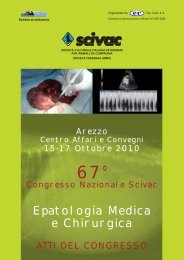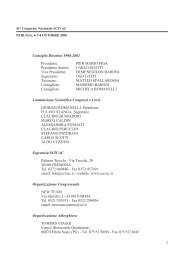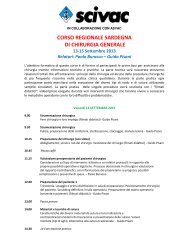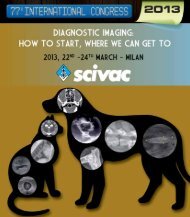58° Congresso Nazionale SCIVAC: Oncologia veterinaria
58° Congresso Nazionale SCIVAC: Oncologia veterinaria
58° Congresso Nazionale SCIVAC: Oncologia veterinaria
Create successful ePaper yourself
Turn your PDF publications into a flip-book with our unique Google optimized e-Paper software.
58° <strong>Congresso</strong> <strong>Nazionale</strong> <strong>SCIVAC</strong> • Milano, 7-9 Marzo 2008 • <strong>Oncologia</strong> <strong>veterinaria</strong> - Alle soglie del III Millennio<br />
diment. There can be over interpretation of the criteria of malignancy in cells<br />
in the urine sediment as inflammation by itself can cause changes that closely<br />
mimic malignancy. Flow cytometry may be more sensitive in the evaluation<br />
of bladder cells in urine. Its use to identify cancer cells may be valuable<br />
in the recognition of malignant cells as well as a sensitive indicator of<br />
response to therapy.<br />
Secondary bacterial infection is also common and there is often reported<br />
an initial response to antibiotic therapy followed by a return of the clinical<br />
signs when antibiotic therapy ceases. A new urine-based diagnostic test is<br />
commercially available in the United States for screening for bladder cancer<br />
in the dog.<br />
This test is referred to as the VBTA test and detects an oncofetal antigen<br />
released by tumors into the urine of affected dogs. While this test is highly<br />
sensitive, it is very non-specific. The test had an overall sensitivity of 90%<br />
and a specificity of 78% in one study of 19 healthy control dogs, 20 dogs<br />
with TCC, and 26 dogs with non-neoplastic urinary disease. Any cause of<br />
hematuria can result in a false positive finding with this assay. For this reason,<br />
we are not commonly using the test and suggest that all positive tests<br />
in a screening setting be validated by careful cytologic, biopsy, and imaging<br />
studies.<br />
Radiography is probably the most valuable tool in the diagnosis of bladder<br />
tumors. Plain radiographs of the abdomen usually do not provide the diagnosis,<br />
however, positive and negative contrast cystograms readily identify mucosal<br />
irregularities, filling defects, and masses.<br />
Radiographs should also be examined for calcification of the bladder<br />
wall, sublumbar lymph node enlargement, prostatomegaly, caudal abdominal<br />
mass, bladder displacement, and periosteal reaction along the lumbar<br />
vertebrae or pelvis.<br />
Ultrasound can be used as a diagnostic tool to look for bladder masses as<br />
well as evaluate the kidneys, ureters, and sublumbar lymph nodes for metastatic<br />
disease. Further, masses within the bladder can be easily measured at<br />
each ultrasound and used to evaluate response to treatment.<br />
Intraveneous urograms are often not necessary to diagnose bladder masses<br />
unless urethral obstruction prevents urinary catheter passage. It is estimated<br />
that 20% of dogs with TCC have metastasis at the time of diagnosis, although<br />
this metastasis may be confined to sublumbar lymph nodes.<br />
Thoracic radiographs to detect evidence of lung metastasis should be performed<br />
at the time of diagnosis. Most typical patterns of pulmonary metastasis<br />
seen with TCC are interstitial nodular and diffuse interstitial patterns.<br />
While much can be gained from performing the above diagnostic tests, the<br />
final diagnostic step should include biopsy. Biopsy can be obtained by cystoscopy,<br />
traumatic catheterization, or cystotomy via laparotomy.<br />
91
















